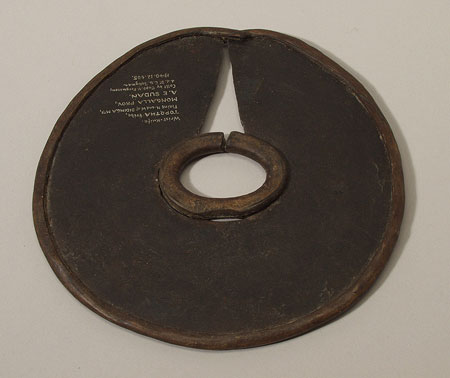Accession Number:
1940.12.605 .1 .2 .3
Country:
Sudan
Region:
[Southern Sudan] [Mongalla Province] Eastern Equatoria North & West of Didinga Hills
Cultural Group:
Toposa
Date Made:
By 1927
Materials:
Iron Metal , Animal Hide Skin
Process:
Forged (Metal) , Hammered
Dimensions:
L = 222 mm, W = 213 mm, th blade 0.5 mm [RTS 5/3/2004]
Weight:
398 g
Other Owners:
Charles Gabriel Seligman
Field Collector:
Vere Henry Fergusson
PRM Source:
Charles Gabriel Seligman or Brenda Zara Seligman
Acquired:
Donated 1940
Collected Date:
by December 1927
Description:
Large wrist knife, made out of a rectangular piece of sheet iron, hammered and bent into a disc shape with flat upper and lower surfaces, and a sharp, curved outer edge.
The ends nearly touch at their outer tips, but have been cut at an angle, so that they slope in and away from each other to the centre of the knife, where there is an oval hole to fit the user's wrist.
The inside edge is rough and irregular, but has been protected by a piece of yellow brown hide (Pantone 464C), possibly leather, that has been wrapped over either side of the blade.
The ends of this inner sheath are cut flat, and just touch each other across the gap between the ends of the blade.
Opposite this point, a piece has been cut away from the centre of the sheath body on the side touching the blade, leaving a slightly concave surface.
A second sheath has been made from a similar, longer piece of hide, fitted over the sharp outer blade edge.
The ends of this piece extend beyond the edges of the blade.
Similar knives sometimes have a metal cap or clip fitted over these ends (see 1979.20.136, from the Larim, or W.
Fischer and M.
Zirngibl, 1978,
African Weapons,
at.
57, from the Turkana).
There are no marks on the surface to suggest that this was the case here.
However it is possible that the inner sheath had such a clip, that would originally have fitted over the centre of the body, where part of the hide has been cut flat.
If so, this inner sheath may have been put back on the knife the wrong way, as on other examples, the clip is positioned across the gap between the blades, not, as here, on the opposite side.
Compare its current position with that of 1979.20.136.
The object is complete, except perhaps for the missing clip; there is either a surface flaw or damaged section on the blade near one end, and some surface corrosion, with the original silvery gray colour of the metal now only visible on the protected blade edges.
Neither sheath was fully removed from the object during cataloguing.
Length across blade and sheath 222 mm, width across blade and sheath 213 mm, thickness of blade 0.5 mm, thickness of outer sheath 6.3 mm, length of inner sheath 76 mm, width of inner sheath 55.6 mm, and thickness of inner sheath 11 mm.
The wrist knife and its sheaths weigh approximately 398 grams.
Collected by Vere Henry Fergusson, presumably at some time between 1916, when he was posted to the Equatorial battalion of the Egyptian army, and December 1927 when he died in the Sudan. Acquired by Charles Gabriel Seligman and donated to the Pitt Rivers Museum in 1940. For discussions of the Toposa, see Captain G.R. King in L.F. Nalder (ed.), 1937, A Tribal Survey of the Mongalla Province, pp 65-81 and A.C. Beaton, 1950, "Record of the Toposa Tribe", Sudan Notes and Records XXXI .
Wrist knives with leather sheaths are found amongst a number of Sudanese groups, including the Larim, Bari and Murle; apparently they were rare amongst the Toposa at the turn of the century, but in common use by the 1930's, and still being used in more recent times (C. Spring 1993, African Arms and Armour, p. 115-6). According to John Mack, Toposa fighting knives of this type are also used for cutting up meat (pers. comm. 8/10/2004).
Rachael Sparks 26/9/2005.
Collected by Vere Henry Fergusson, presumably at some time between 1916, when he was posted to the Equatorial battalion of the Egyptian army, and December 1927 when he died in the Sudan. Acquired by Charles Gabriel Seligman and donated to the Pitt Rivers Museum in 1940. For discussions of the Toposa, see Captain G.R. King in L.F. Nalder (ed.), 1937, A Tribal Survey of the Mongalla Province, pp 65-81 and A.C. Beaton, 1950, "Record of the Toposa Tribe", Sudan Notes and Records XXXI .
Wrist knives with leather sheaths are found amongst a number of Sudanese groups, including the Larim, Bari and Murle; apparently they were rare amongst the Toposa at the turn of the century, but in common use by the 1930's, and still being used in more recent times (C. Spring 1993, African Arms and Armour, p. 115-6). According to John Mack, Toposa fighting knives of this type are also used for cutting up meat (pers. comm. 8/10/2004).
Rachael Sparks 26/9/2005.
Primary Documentation:
Accession Book Entry
[p.
468]
The late Professor C.G.
SELIGMAN, M.D., F.R.S.
Miscellaneous collection presented in part by himself, June, 1940, and in part, after his death, by Mrs B.Z.
Seligman, October, 1940.
[p.
500] 1940.12.605 - Large disc-shaped wrist-knife, the outer and inner edges guarded with leather sheaths.
TOPOTHA tribe (Collector writes: TOPOSA), Plains N.
and W.
of DIDINGA MTS., MONGALLA Prov., A[nglo].E[gyptian].
SUDAN.
Colld.
by Capt.
V.
Fergusson.
Card Catalogue Entry - There is no further information on the tribes catalogue card [RTS 23/7/2004].
Written on object - Wrist-knife. TOPOTHA tribe, plains N. and W. of DIDINGA MTS, MONGALLA PROV., A.E. SUDAN. Colld by Capt. V. Fergusson; d.d. Dr C.G. Seligman [RTS 5/3/2004].
Card Catalogue Entry - There is no further information on the tribes catalogue card [RTS 23/7/2004].
Written on object - Wrist-knife. TOPOTHA tribe, plains N. and W. of DIDINGA MTS, MONGALLA PROV., A.E. SUDAN. Colld by Capt. V. Fergusson; d.d. Dr C.G. Seligman [RTS 5/3/2004].



